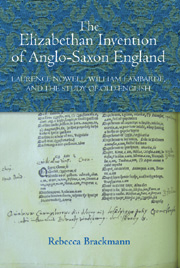 The Elizabethan Invention of Anglo-Saxon England
The Elizabethan Invention of Anglo-Saxon England Book contents
- Frontmatter
- Contents
- List of Illustrations
- Dedication
- Acknowledgements
- Chapter 1 The Anglo-Saxonists and Their Books: Print, Manuscript, and the Circulation of Scholarship
- PART I ANGLO-SAXON TEXTS AND SIXTEENTH-CENTURY ENGLISH
- PART II CHOROGRAPHIES AND THE PAST OF ENGLAND
- Chapter 4 Somewhere in Time: The Abcedarium Place-Name Index
- Chapter 5 Putting the Past in Place: Lambarde's Alphabetical Description and Perambulation of Kent
- Chapter 6 Images and Imaginings of England
- PART III OLD ENGLISH AND THE COMMON LAW
- Conclusion: The Invention of Anglo-Saxon England
- Bibliography
- Index
- Title in the Series
Chapter 5 - Putting the Past in Place: Lambarde's Alphabetical Description and Perambulation of Kent
from PART II - CHOROGRAPHIES AND THE PAST OF ENGLAND
Published online by Cambridge University Press: 05 February 2013
- Frontmatter
- Contents
- List of Illustrations
- Dedication
- Acknowledgements
- Chapter 1 The Anglo-Saxonists and Their Books: Print, Manuscript, and the Circulation of Scholarship
- PART I ANGLO-SAXON TEXTS AND SIXTEENTH-CENTURY ENGLISH
- PART II CHOROGRAPHIES AND THE PAST OF ENGLAND
- Chapter 4 Somewhere in Time: The Abcedarium Place-Name Index
- Chapter 5 Putting the Past in Place: Lambarde's Alphabetical Description and Perambulation of Kent
- Chapter 6 Images and Imaginings of England
- PART III OLD ENGLISH AND THE COMMON LAW
- Conclusion: The Invention of Anglo-Saxon England
- Bibliography
- Index
- Title in the Series
Summary
Writing about places in early modern England was more than just a fad. Maps, perambulations, county and city histories, and poetic or prosaic depictions of various locales came steadily from the presses and circulated in manuscript; not everyone had the linguistic or cartographic training to produce these chorographic words, but they were consumed eagerly by wide numbers. Several early modern hands other than Nowell's and Lambarde's can be found in some of Nowell's manuscripts, noting place names in the margins. This fascination with place had been recognized by scholars (if not by the editors of student anthologies, which almost never include chorographic works) even before Richard Helgerson pointed out that modern genre distinctions had partially hidden the interrelations between texts seen as similar in the Renaissance and showed that the chorographic phenomenon was even more widespread than had been realized. For instance, Lambarde had been known as ‘The Perambulator’ for years, and this moniker was sufficiently well circulated for Wilbur Dunkel to include it in a chapter title in his 1965 biography of Lambarde without explanation or attribution.
Helgerson's foundational study illuminates the relationships between genres that modern scholars had viewed as separate, but within this chorographic mode, individual works still functioned differently. Ultimately Nowell, Lambarde, and later authors such as Camden wrote chorography for different purposes, although some of the reasons that such studies stayed popular persisted throughout the latter half of the sixteenth century and the start of the seventeenth.
- Type
- Chapter
- Information
- The Elizabethan Invention of Anglo-Saxon EnglandLaurence Nowell, William Lambarde, and the Study of Old English, pp. 120 - 147Publisher: Boydell & BrewerPrint publication year: 2012


